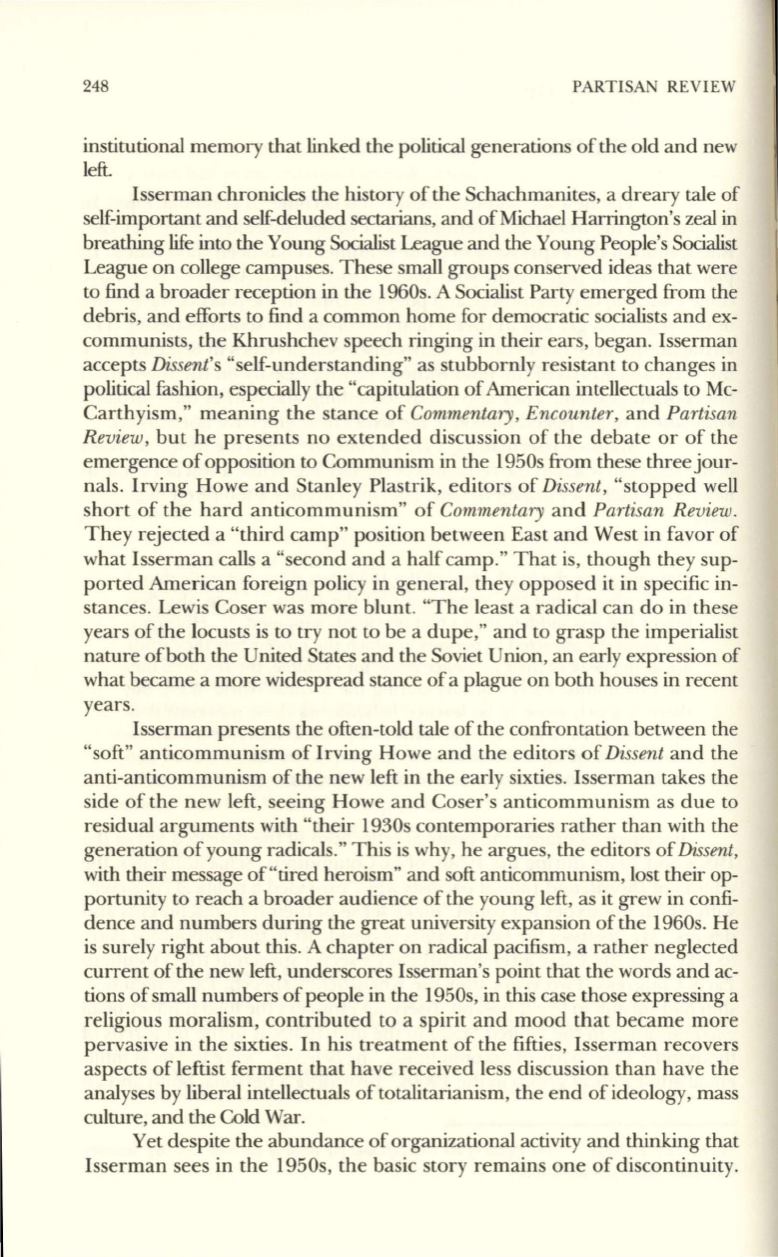
248
PARTISA REVIEW
institutional memory that linked the political generations of the old and new
left.
Isserman chronicles the history of the Schachmanites, a dreary tale of
self-important and self-deluded sectarians, and ofMichael Harrington's zeal in
breathing life into the Young Socialist League and the Young People's Socialist
League on college campuses. These small groups conserved ideas that were
to find a broader reception in the 1960s. A Socialist Party emerged from the
debris, and efforts to find a common home for democratic socialists and ex–
communists, the Khrushchev speech ringing in their ears, began. Isserman
accepts
Dissent's
"self-understanding" as stubbornly resistant to changes in
political fashion, especially the "capitulation ofAmerican intellectuals to Mc–
Carthyism," meaning the stance of
Commentary, Encounter ,
and
Partisan
Review,
but he presents no extended discussion of the debate or of the
emergence of opposition to Communism in the 1950s from these three jour–
nals. Irving Howe and Stanley Plastrik, editors of
Dissent,
"stopped well
short of the hard anticommunism" of
Commentary
and
Partisan R eview.
They rejected a "third camp" position between East and West in favor of
what Isserman calls a "second and a half camp." That is, though they sup–
ported American foreign policy in general, they opposed it in specific in–
stances. Lewis Coser was more blunt. "The least a radical can do in these
years of the locusts is to try not to be a dupe," and to grasp the imperialist
nature of both the United States and the Soviet Union, an early expression of
what became a more widespread stance of a plague on both houses in recent
years.
Isserman presents the often-told tale of the confrontation between the
"soft" anticommunism of Irving Howe and the editors of
Dissent
and the
anti-anticommunism of the new left in the early sixties. Isserman takes the
side of the new left, seeing Howe and Coser's anticommunism as due to
residual arguments with "their 1930s contemporaries rather than with the
generation of young radicals." This is why, he argues, the editors of
Dissent,
with their message of "tired heroism" and soft anticommunism, lost their op–
portunity to reach a broader audience of the young left, as it grew in confi–
dence and numbers during the great university expansion of the 1960s. He
is surely right about this. A chapter on radical pacifism, a rather neglected
current of the new left, underscores Isserman's point that the words and ac–
tions of small numbers of people in the 1950s, in this case those expressing a
religious moralism, contributed to a spirit and mood that became more
pervasive in the sixties. In his treatment of the fifties , Isserman recovers
aspects of leftist ferment that have received less discussion than have the
analyses by liberal intellectuals of totalitarianism, the end of ideology, mass
culture, and the Cold War.
Yet despite the abundance of organizational activity and thinking that
Isserman sees in the 1950s, the basic story remains one of discontinuity.


